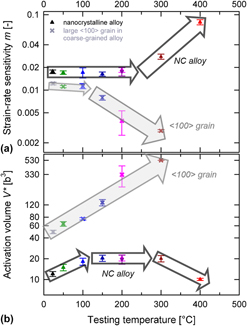Crossref Citations
This article has been cited by the following publications. This list is generated based on data provided by
Crossref.
Lee, Dong-Hyun
Choi, In-Chul
Yang, Guanghui
Lu, Zhaoping
Kawasaki, Megumi
Ramamurty, Upadrasta
Schwaiger, Ruth
and
Jang, Jae-il
2018.
Activation energy for plastic flow in nanocrystalline CoCrFeMnNi high-entropy alloy: A high temperature nanoindentation study.
Scripta Materialia,
Vol. 156,
Issue. ,
p.
129.
Zou, Yu
2018.
Nanomechanical studies of high-entropy alloys.
Journal of Materials Research,
Vol. 33,
Issue. 19,
p.
3035.
Schuh, Benjamin
Völker, Bernhard
Todt, Juraj
Kormout, Karoline S.
Schell, Norbert
and
Hohenwarter, Anton
2018.
Influence of Annealing on Microstructure and Mechanical Properties of a Nanocrystalline CrCoNi Medium-Entropy Alloy.
Materials,
Vol. 11,
Issue. 5,
p.
662.
Surjadi, James Utama
Gao, Libo
Cao, Ke
Fan, Rong
and
Lu, Yang
2018.
Mechanical Enhancement of Core-Shell Microlattices through High-Entropy Alloy Coating.
Scientific Reports,
Vol. 8,
Issue. 1,
Chavoshi, Saeed Zare
and
Xu, Shuozhi
2018.
Temperature-dependent nanoindentation response of materials.
MRS Communications,
Vol. 8,
Issue. 1,
p.
15.
Wang, Shao-Ping
Ma, Evan
and
Xu, Jian
2018.
Notch fracture toughness of body-centered-cubic (TiZrNbTa) Mo high-entropy alloys.
Intermetallics,
Vol. 103,
Issue. ,
p.
78.
Xiao, Gesheng
Li, Zhigang
Liu, Erqiang
Qiao, Li
Yang, Xuexia
Shu, Xuefeng
and
Sun, Ruijing
2018.
WITHDRAWN: Strain rate and temperature effects on the mechanical properties of cured isotropic conductive adhesive (ICA) at micro scale.
Mechanics of Materials,
Beake, Ben D.
and
Harris, Adrian J.
2019.
Nanomechanics to 1000 °C for high temperature mechanical properties of bulk materials and hard coatings.
Vacuum,
Vol. 159,
Issue. ,
p.
17.
Xia, Wenzhen
Dehm, Gerhard
and
Brinckmann, Steffen
2019.
Unraveling indentation-induced slip steps in austenitic stainless steel.
Materials & Design,
Vol. 183,
Issue. ,
p.
108169.
Lee, Dong-Hyun
Park, Jeong-Min
Yang, Guanghui
He, Junyang
Lu, Zhaoping
Suh, Jin-Yoo
Kawasaki, Megumi
Ramamurty, Upadrasta
and
Jang, Jae-il
2019.
Nano-graining a particle-strengthened high-entropy alloy.
Scripta Materialia,
Vol. 163,
Issue. ,
p.
24.
Abhijit, A.
Varghese, J.
Chalavadi, P.
Sai Karthik, P.
Bhanu Sankara Rao, K.
and
Rajulapati, K. V.
2019.
Negative Strain Rate Sensitivity in Two-Phase Nanocrystalline CoCrFeMnNi High-Entropy Alloy with Broader Grain Size Distribution Studied by Nanoindentation.
Transactions of the Indian Institute of Metals,
Vol. 72,
Issue. 10,
p.
2861.
Wang, Jie
Hao, XiaoYun
Jiang, YouXiang
Zhang, DongEn
Ren, LiZhen
Gong, JunYan
Wu, XiuJuan
Zhang, YuanYuan
and
Tong, ZhiWei
2019.
Synthesis, structure, and photocatalytic activity of PANI/BiOCl nanocomposites.
Materials Research Express,
Vol. 6,
Issue. 8,
p.
0850c1.
Zhu, Bo
Zhao, Dan
Tian, Yuan
Wang, Shunbo
Zhao, Hongwei
and
Zhang, Jianhai
2019.
Study on the deformation mechanism of spherical diamond indenter and its influence on 3C-SiC sample during nanoindentation process via molecular dynamics simulation.
Materials Science in Semiconductor Processing,
Vol. 90,
Issue. ,
p.
143.
Choi, In-Chul
and
Jang, Jae-il
2020.
A Survey of Nanoindentation Studies on HPT‐Processed Materials.
Advanced Engineering Materials,
Vol. 22,
Issue. 1,
Meisenheimer, P. B.
and
Heron, J. T.
2020.
Oxides and the high entropy regime: A new mix for engineering physical properties.
MRS Advances,
Vol. 5,
Issue. 64,
p.
3419.
Clemens, H.
2020.
The Development and Characterization of High-Performance Materials: A Retrospective Article.
Practical Metallography,
Vol. 57,
Issue. 9,
p.
614.
Zhao, Yakai
Wang, Xutao
Cao, Tangqing
Han, Jae-Kyung
Kawasaki, Megumi
Jang, Jae-il
Han, Heung Nam
Ramamurty, Upadrasta
Wang, Lu
and
Xue, Yunfei
2020.
Effect of grain size on the strain rate sensitivity of CoCrFeNi high-entropy alloy.
Materials Science and Engineering: A,
Vol. 782,
Issue. ,
p.
139281.
Ye, Y.X.
Ouyang, B.
Liu, C.Z.
Duscher, G.J.
and
Nieh, T.G.
2020.
Effect of interstitial oxygen and nitrogen on incipient plasticity of NbTiZrHf high-entropy alloys.
Acta Materialia,
Vol. 199,
Issue. ,
p.
413.
Meng, Lu
Qiu, Ji
Wang, Zhihua
Liu, Erqiang
Shu, Xuefeng
and
Xiao, Gesheng
2020.
Indentation pop-in behavior of CoCrFeNiAl0.3 high-entropy alloy.
Materials Research Express,
Vol. 6,
Issue. 12,
p.
1265d4.
Siska, Filip
Cech, Jaroslav
Hausild, Petr
Hadraba, Hynek
Chlup, Zdenek
Husak, Roman
and
Stratil, Ludek
2020.
Twinning in CoCrFeNiMn high entropy alloy induced by nanoindentation.
Materials Science and Engineering: A,
Vol. 784,
Issue. ,
p.
139297.





